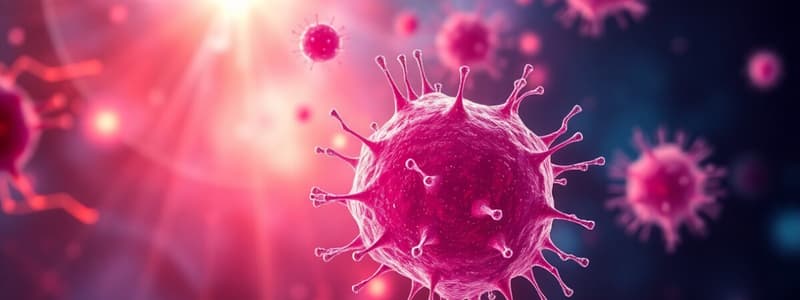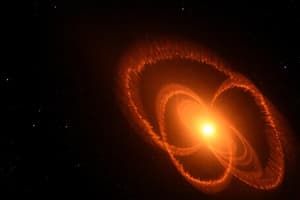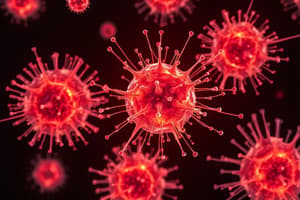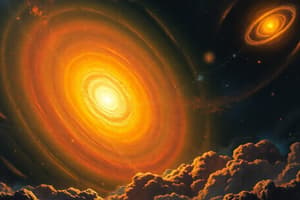Podcast
Questions and Answers
What year was Jocelyn Bell Burnell awarded the title of Dame Commander of the British Empire (DBE)?
What year was Jocelyn Bell Burnell awarded the title of Dame Commander of the British Empire (DBE)?
- 1974
- 1967
- 1988
- 2007 (correct)
Which significant term was introduced in 1968 due to Jocelyn Bell Burnell's discovery?
Which significant term was introduced in 1968 due to Jocelyn Bell Burnell's discovery?
- Neutron star
- Radio wave
- Quasar
- Pulsar (correct)
What unique genetic sequence did Tak Wah Mak discover in 1983?
What unique genetic sequence did Tak Wah Mak discover in 1983?
- Antibody recognition sequence
- Sequence responsible for cancer cell mutation
- T-cell receptor sequence (correct)
- Cytokine production sequence
In which year did Antony Hewish receive the Nobel Prize related to Jocelyn Bell Burnell's work?
In which year did Antony Hewish receive the Nobel Prize related to Jocelyn Bell Burnell's work?
What was the main focus of Tak Wah Mak's research throughout his career?
What was the main focus of Tak Wah Mak's research throughout his career?
What did Jocelyn Bell Burnell's instruments detect in November 1967?
What did Jocelyn Bell Burnell's instruments detect in November 1967?
Which type of cancer did Tak Wah Mak identify a chemical to block the fuel supply for?
Which type of cancer did Tak Wah Mak identify a chemical to block the fuel supply for?
Where did Tak Wah Mak complete his PhD in biochemistry?
Where did Tak Wah Mak complete his PhD in biochemistry?
Flashcards
What is a pulsar?
What is a pulsar?
A celestial object that emits pulses of electromagnetic radiation at regular intervals.
Who discovered the first pulsar and who received the Nobel Prize?
Who discovered the first pulsar and who received the Nobel Prize?
Jocelyn Bell Burnell discovered the first pulsar in 1967. Antony Hewish and Bell Burnell published the findings in Nature, but only Hewish received the Nobel Prize in 1974.
What are T-cells and what did Tak Wah Mak discover about them?
What are T-cells and what did Tak Wah Mak discover about them?
T-cells are white blood cells that recognize antigens, which are molecules foreign to the body. Tak Wah Mak discovered that T-cell receptors have a unique genetic sequence.
What is antigen recognition and how did Mak's discovery help?
What is antigen recognition and how did Mak's discovery help?
Signup and view all the flashcards
Where was Jocelyn Bell Burnell when she made her discovery?
Where was Jocelyn Bell Burnell when she made her discovery?
Signup and view all the flashcards
Where was Tak Wah Mak born and educated?
Where was Tak Wah Mak born and educated?
Signup and view all the flashcards
What was the impact of the pulsar discovery?
What was the impact of the pulsar discovery?
Signup and view all the flashcards
What was the impact of Tak Wah Mak's research?
What was the impact of Tak Wah Mak's research?
Signup and view all the flashcards
Study Notes
Jocelyn Bell Burnell
- First scientist to detect pulsars
- Opened a new branch of astrophysics
- Born in Belfast, Northern Ireland
- Developed a flair for science at school
- Resolved to work in astronomy
- Graduated from Glasgow University in 1965
- PhD thesis on twinkling quasars at Cambridge University
- Helped design and build radio telescopes
- Discovered pulsars in November 1967
- Unexpected radio waves pulsating every 1.337 seconds
- Similar signals detected in other parts of space
- Concluded radio waves from a rapidly rotating, strongly magnetized neutron star (pulsar)
- Coined the term "pulsar" in 1968
Tak Wah Mak
- Immunologist and molecular biologist
- Solved a longstanding problem in immunology
- Discovered how T-cells recognize antigens
- Breakthrough in 1983
- T-cells recognize antigens using unique genetic sequences
- Studied at the University of Wisconsin and the University of Alberta
- Discovered the genetic sequence of T-cell receptors
- Opened up a new chapter in the study and treatment of immune-system diseases
- Applied molecular techniques to learn more about immune responses to cancer
- Quote: "We can never give up the fight against cancer"
Studying That Suits You
Use AI to generate personalized quizzes and flashcards to suit your learning preferences.





